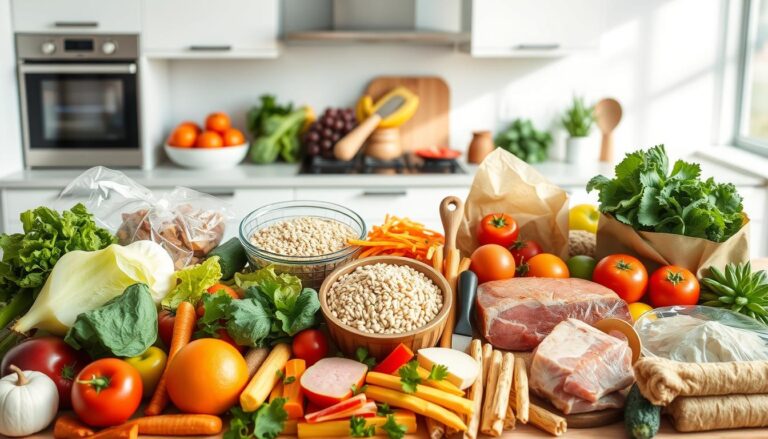For years, people have argued over whether diet or exercise is better for losing fat. Now science backs up the idea that diet is key making up 80% of weight loss. Colleen Alrutz a health expert says diet alone can lead to 70% of initial weight loss.
But exercise is not to be ignored. It helps keep the weight off. Think about this: skipping a Starbucks venti Green Tea Frappuccino 520 calories is like burning the same calories in an hour of cycling. Exercise not only boosts your metabolism but also your heart health.
Studies show that combining diet and exercise can lead to weight loss five times faster than just exercising. This proves that both are essential for achieving your goals.
Key Takeaways
- The 80/20 rule prioritizes diet as 80% of fat loss success.
- Combining diet and exercise can achieve weight loss five times faster than exercise alone.
- Saving 520 calories by skipping one sugary drink equals an hour of moderate cycling.
- Strength training boosts metabolism for up to 72 hours post-workout.
- A 500-calorie daily deficit through diet and exercise cuts a pound in under five days.
Understanding the Fat Loss Equation
At the heart of fat loss is a simple idea: energy balance. To lose weight, you must burn more calories than you eat. This idea is key to any successful plan, whether it’s diet, exercise, or both.
Calories In vs Calories Out The Basic Principle
To lose one pound of fat each week, you need a 3,500-calorie deficit. This means eating less and moving more. For example, eating 500 calories less and exercising to burn 500 calories helps you lose weight steadily. But, keeping this balance right is hard.
The Role of Metabolism in Fat Loss
Metabolism is how well your body turns food into energy. Your basal metabolic rate BMR and how active you are affect how many calories you burn. Eating protein and exercising can improve metabolism and help keep muscle mass. A 2018 study found that eating 30-35% of your calories as protein helps keep muscle while losing weight.

| Gender | Recommended Daily Protein Intake grams |
|---|---|
| Men | 34–56 g |
| Women | 34–46 g |
Why Most People Struggle with Sustainable Fat Loss
Many factors make it hard to keep losing weight over time. Your body can adapt to burn fewer calories when you eat less and you might feel hungrier. Emotional eating also makes it tough. But eating a lot of protein and exercising regularly as the CDC suggests, can help with both physical and mental challenges.
The Science Behind Body Fat and Weight Loss
Body fat is made up of fat cells that store energy as triglycerides. There are three types: white fat, brown fat, and beige fat. White fat stores energy, brown fat generates heat, and beige fat has intermediate roles.
Hormones like insulin and leptin play a big part in how fat cells work. Insulin helps control glucose and fat storage, while leptin signals when we’re full. Ghrelin, the hunger hormone tells us when it’s time to eat. This balance is key to fat loss.
| Type | Function | Key Role |
|---|---|---|
| White Fat | Stores energy | Primary fat type, linked to healthy weight loss goals |
| Brown Fat | Generates heat | Activates in cold environments to burn calories |
| Beige Fat | Hybrid properties | Activates during exercise or diet changes |

When we lose weight on a diet, our body shrinks fat cells, not gets rid of them. Research shows losing weight too fast can lead to losing muscle. To keep muscle, adults need to eat 0.8–1.5g of protein for every kilogram of body weight, based on how active they are.
Eating too much protein more than 2.5g/kg can harm the kidneys. Visceral fat which is fat around organs, is more dangerous than fat under the skin. Losing weight can slow down our metabolism making us hungrier and making it harder to keep weight off.
- Visceral fat around organs increases disease risk more than subcutaneous fat under skin
- Metabolic slowdown during weight loss triggers hunger hormones complicating long-term success
- NEAT nonexercise activity thermogenesis burns 100–800 daily calories
To lose weight in a healthy way, we need to balance what we eat with how active we are. The 2020 Dietary Guidelines suggest eating 500–750 fewer calories a day for safe weight loss. Adding exercise helps keep muscle and makes losing weight more sustainable.
What’s Better for Fat Loss Diet or Exercise?
When looking at diet vs exercise for weight loss, each plays a key role. Studies show diet is responsible for 70% of short term fat loss, as Colleen Alrutz points out.
A 2023 study with 145 women aged 40–60 showed that combining diet and exercise led to a 3.5–3.9kg weight loss over 8 weeks. In contrast, those who only exercised saw no change.

Short-Term Results: Diet vs Exercise
Dietary changes lead to quicker results. In the study, the diet only group lost 3.5kg. Those who also exercised lost an extra 0.4kg. Exercise alone did not lead to weight loss, showing diet’s importance in early success.
You can always out-eat your exercise Alrutz notes. This highlights the need for diet compliance in early progress.
Long-Term Sustainability Which Approach Wins?
Exercise is key for keeping weight off. The National Weight Control Registry found 90% of people who maintained weight loss for years focused on exercise. Strength training increases metabolism by 7–8% for each kilogram of muscle gained.
This metabolic boost helps fight the 95% relapse rate seen in diet-only programs after 12 months.
Research Findings on Diet vs Exercise Effectiveness
Meta analyses show that combining diet and exercise is more effective. Deborah Riebe’s research found diet-exercise plans lead to 20% more weight loss than diet alone. A
you cannot outrun a bad diet
from the British Journal of Sports Medicine highlights the importance of both. For lasting success, a balance between diet and exercise is essential.
How Diet Impacts Your Fat Loss Journey

A caloric deficit is key for fat burning. To lose one pound, you need a 3,500-calorie deficit. For healthy weight loss, aim for 0.5–1kg weekly. This can be achieved by eating less and moving more.
The Mayo Clinic Diet shows this works. It allows up to 10 pounds lost in two weeks. This is done through structured phases.
Macronutrient balance is important for lasting results. Foods high in protein, like chicken and lentils, help you feel full. They also help keep your muscle mass when you’re eating less. Here’s a table showing the best ratios:
| Nutrient | Role | Recommended Intake |
|---|---|---|
| Protein | Muscle preservation | 10-35% of daily calories |
| Fiber | Appetite regulation | 25-38g per day |
| Healthy Fats | Metabolic regulation | 20-35% of calories |
Diets like the Mediterranean and intermittent fasting work well if they fit your life. The Mayo Clinic Diet focuses on vegetables, lean proteins, and whole grains. These are key for 90% of people who lose weight for good.
Studies show that eating 4 servings of vegetables a day and exercising moderately helps more than just counting calories. This makes it easier to stick to a diet.
Psychological factors are also important. Eating extra calories after working out can undo the benefits. The Mayo Clinic’s program teaches habits over strict rules. This approach is backed by the NIH and helps you make lasting changes.
Exercise’s Role in Burning Fat and Building Fitness
Exercise helps burn fat by making your body work harder and keeping muscle strong. Strength training, for example, builds muscle. This muscle then burns more calories, even when you’re not moving.
A single workout can boost your metabolism for up to 72 hours. This helps you lose fat over time.
Studies show that activities like walking or cycling burn calories right away. They help with fat loss, as long as you eat fewer calories. On the other hand, resistance training keeps your muscle mass high. This stops your metabolism from slowing down when you diet.
The American College of Sports Medicine suggests a mix of exercise. They recommend 150 minutes of aerobic activity each week. Plus, do strength training twice a week.
- Aerobic exercise: burns calories during activity and improves cardiovascular health.
- Resistance training: preserves muscle, boosting metabolism and fat oxidation at rest.
- High-intensity interval training HIIT enhances post-exercise calorie burn through EPOC excess post-exercise oxygen consumption.
The National Weight Control Registry found that 94% of people who kept off weight exercised regularly. While exercise alone might not lead to huge weight loss, it helps. Adding healthy eating to your routine can lead to better results.
The 2016 AACE guidelines say 150–300 minutes of moderate aerobic exercise a week is good. It improves how your body handles insulin and fat.
To reach your fitness goals, focus on being consistent, not just how hard you work out. The CDC says adults should do muscle-strengthening activities twice a week. Combine this with healthy eating for lasting fat loss and better health.
Combining Diet and Exercise The Winning Strategy
Studies show that mixing healthy weight loss methods like diet vs exercise works best. A study with 1,022 people found that combining diet and exercise led to more weight loss than exercise alone.
For example eating 500 fewer calories and exercising to burn 350 calories can help lose a pound in about four days. This is 30% faster than dieting alone.
Creating Synergy Between Nutrition and Physical Activity
Using both calorie cuts and exercise boosts can be powerful. Eating less helps keep a steady calorie deficit while working out helps keep muscle and raises metabolism. The American Heart Association suggests:
At least 150 minutes of moderate cardio weekly, paired with strength training twice weekly.
This mix helps reach fitness goals and stops muscle loss during calorie cutting phases.
Designing a Balanced Approach for Maximum Results
To effectively combine diet and exercise, consider:
- A 500–750 calorie daily deficit through portion control and nutrient-dense foods
- 150–300 minutes of weekly exercise, combining cardio and resistance training
- Behavioral strategies like self-monitoring e.g. tracking meals/exercise
People in the National Weight Control Registry do 60 minutes of daily activity and log their food. This matches what research suggests.
Timeline Expectations for Combined Approaches
Start with slow progress: aim for 0.5–2 pounds a week. Over 6–12 months, you can keep losing weight.
Studies show that after 12 months, diet and exercise together lead to more weight loss than diet alone. Sticking to this plan for a year can help avoid weight gain, with 75% of studies showing less weight regain. On average, people lose about 7.2kg over 6–12 months, according to long-term studies.
Common Misconceptions About Fat Loss
Many myths about fat loss exist, despite solid science. Let’s debunk three common ones to guide you to proven methods.
Spot Reduction Myths
Doing specific exercise like crunches won’t just melt belly fat. Fat loss happens all over, not just in one spot. Studies show that while crunches can make muscles look better, they don’t get rid of fat.
So focus on losing fat all over with a balanced diet and regular cardio.
Fat Burning Supplements Marketing vs. Reality
Most supplements offer minimal to no benefit beyond placebo effects.
Products like green tea extract or caffeine might slightly increase your metabolism. But, their impact is small unless you also change your diet and exercise habits. The supplement world loves making big claims without proof. Stick to eating real foods instead of relying on pills.
Exercise Alone Falls Short
You can’t outrun a bad diet is true. Exercise burns fewer calories than people think. For example a 45-minute workout might burn 300–400 calories. But a single sugary drink can undo all that.
Combining exercise with a controlled diet is key for lasting results. Research shows that 85% of people who diet without changing their diet and exercise habits will gain back weight.
- Spot reduction ignores systemic fat metabolism
- Supplements contribute minimally without lifestyle changes
- Calorie deficits require dietary control alongside physical activity
Real success comes from proven methods not quick fixes.
Tailoring Your Approach: Personalized Fat Loss Strategies
Successful fat loss means finding strategies that fit your unique biology and preferences. fitness goals are different for everyone, and a single diet or workout plan doesn’t work for all. Genetics play a big role, affecting how your body reacts to food.
- Genetic factors: DNA testing e.g., 23andMe reveals how your body processes fats, carbs, and protein.
- Metabolic markers: Testing hormones like leptin and ghrelin can clarify hunger patterns.
- Lifestyle factors: Time constraints, food preferences, and medical conditions must guide plan design.
Personalized nutrition improves adherence by 30% compared to generic diets, according to clinical studies.
Begin by checking your starting point. A registered dietitian can craft a diet based on your genetic makeup. For instance, certain genes might do better with high-protein or high-fat diets. Choose exercises that fit your goals, like strength training or cardio.
Build lasting habits to improve metabolism and keep results. Monitor your progress each week and tweak your diet or workout as needed. Aim for a slow weight loss of 0.5–2 lbs per week. Diets like the Mediterranean or DASH offer flexibility and balanced nutrition, helping avoid extreme dieting.
Seek medical advice if you hit a plateau. A healthcare provider can check for hormonal issues or other health problems. Mixing DNA-based diet plans with specific workouts can increase energy by 40% and lower inflammation. The key is to stay consistent, not to be perfect.
Conclusion: Finding Your Sustainable Path to Fat Loss
A balanced mix of diet and exercise is key for lasting fat loss and health. A study at Arizona State University found 70% of people regained fat, even with regular treadmill workouts. This shows the importance of changing what you eat.
Creating a caloric deficit of 500–1,000 calories a week is safe for losing 0.5–1 kg. Exercise helps keep muscle mass and boosts metabolic health. For example resistance training can reduce muscle loss by up to 90% during weight loss, as found in the Obesity Journal.
Guidelines from Singapore suggest 150–300 minutes of moderate exercise each week. They also recommend My Healthy Plate’s food balance quarter grains, quarter protein, half vegetables. Diet plays a big role in weight loss, with 80% of it coming from what you eat.
Exercise is important for keeping weight off. Apps like Jefit, used by 12 million, help track progress. Remember, everyone’s body is different, but small, steady changes are better than extreme diets.
Don’t believe in spot reduction or magic supplements. Stick to whole foods, drink plenty of water, and stay active. A study showed that combining diet and exercise leads to better muscle retention and metabolic health. Always talk to a healthcare provider for a plan that fits your needs and goals.





